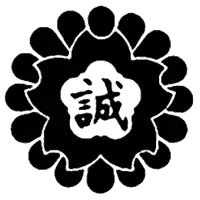Kyushu Seido-kai
The Kyushu Seido-kai (九州誠道会, Kyūshū Seidō-kai) was a yakuza organization based in Fukuoka Prefecture on the Kyushu island of Japan, with an estimated 380 active members.[1] Headquartered in the southern Fukuoka region of Omuta, the Kyushu Seido-kai maintains its offices in five other prefectures including Tokyo.[2]
 Daimon of Kyushu Seido-kai | |
| Founding location | Omuta, Fukuoka, Japan |
|---|---|
| Years active | 2006 - June 11th, 2013 |
| Membership (est.) | 380 |
| Criminal activities | Drug trafficking, loansharking, among others |
| Rivals | Dojin-kai |
Since its formation, the Kyushu Seido-kai has been known for its blatant armed conflicts with its former parent syndicate, the Dojin-kai,[3] involving various hazardous weapons such as automatic firearms (especially the AK-47), petrol bombs and hand grenades.
While violently feuding with the Dojin-kai, the Kyushu Seido-kai has caused deaths among several innocent civilians as well as numerous yakuza members,[4] and because of that, despite being a relatively recently established group, the Kyushu Seido-kai has been a designated yakuza group since 2008.[5]
History
The Kyushu Seido-kai launched in 2006 as the Dojin-kai's splinter group[6] led by the Omuta-based Murakami-ikka clan,[5] after the long-time Dojin-kai boss Seijiro Matsuo announced his resignation, sparking a war of succession.[7] In 2007 a Dojin-kai member attempted to murder a Seido-kai member, but ended up killing an innocent bystander.[8] The Kyushu Seido-kai ended up receiving official registration as a designated yakuza group under the Organized Crime Countermeasures Law on February 28, 2008.[9]
In 2011, the Seido-kai's feud with the Dojin-kai escalated,[10] and many Seido members were killed by the Dojin-kai; two Seido seniors were killed by alleged Dojin-kai's grenades in Omuta (April),[11] one Seido member was stabbed to death in Ogi, Saga (April),[12] and one Seido senior was shot to death in Imari, Saga (April).[13]
Condition
The Kyushu Seido-kai is one of the five independent Fukuoka-based designated yakuza syndicates, along with the Kudo-kai, the Taishu-kai, the Fukuhaku-kai, and the Dojin-kai.[1] The Kyushu Seido-kai maintains its offices in six prefectures;[2] Fukuoka, Saga, Nagasaki, Kumamoto, Yamagata,[14] and Tokyo.[2]
In 2008, the Kudo-kai's third-generation president Hideo Mizoshita died and his funeral was attended by many yakuza magnates representing their respective syndicates from all over the country. The Seido-kai was the only designated yakuza syndicate absent from this event.[15]
The second president Namikawa has allegedly maintained a close relationship with Kunio Inoue. Inoue is the president of the fourth-generation Yamaken-gumi, an affiliate of the largest-known Yamaguchi-gumi syndicate.[16]
Activities
The Kyushu Seido-kai's illegal activities have allegedly included loansharking and methamphetamine trafficking.[17] The Seido-kai was allegedly the largest drug trading division of the Dojin-kai, as rumored by some local Omuta in-the-know men, hence the informal dub name of the "Seido Pharmacy". Even the 55-year-old founding president Murakami was arrested for methamphetamine possession.
On June 11, 2013, Kyushu Seido-kai announced the end of its gang war with Dojin-kai as well as its dissolution.[18]
Leadership
- 1st president : Chojiro Murakami
- 2nd president : Masahiro Namikawa
References
- "Police of Japan 2011, Criminal Investigation : 2. Fight Against Organized Crime" Archived 2011-08-10 at the Wayback Machine, December 2009, National Police Agency
- "Boryokudan Situation in 2010", April 2011, National Police Agency (in Japanese)
- "Gangster tied to slaying in Saga hospital arrested", 26 November 2007, The Japan Times
- "Firing on a car belonging to a Dojin-kai insider, possibly from a conflict with the Seido-kai" Archived 2011-09-30 at the Wayback Machine, 30 March 2011, Yomiuri Shimbun (in Japanese)
- "National Police Agency searches the Kyushu Seidokai's office, for blackmail among others", 31 October 2008, Sankei Shimbun (in Japanese)
- "Japan: Residents go to courts to evict yakuza", 26 August 2008, The Guardian
- "The town that took on the yakuza", 9 September 2008, The Independent
- http://www.japantimes.co.jp/text/nn20071126a3.html
- "Boryokudan Situation in 2007" Archived 2015-11-12 at the Wayback Machine, April 2008, National Police Agency (in Japanese)
- "Shot : One hurt in the Dojin-kai President's house, Kurume", 26 August 2011, Mainichi Shimbun (in Japanese)
- "Explosive in car kills ex-gang boss, brother", 8 April 2011, Yomiuri Shimbun
- "Seido-kai member was stabbed to death immediately after getting off his car" Archived 2011-07-14 at the Wayback Machine, 21 April 2011, Sankei Shimbun (in Japanese)
- "Hospital murder, Dojin-kai member was arrested" Archived 2011-07-13 at the Wayback Machine, 10 July 2011, Yomiuri Shimbun (in Japanese)
- "Kyushu Seido-kai as a shitei boryokudan, The Fukuoka Prefectural Public Safety Commission started the procedures", 27 December 2007, Chiba Nippo (in Japanese)
- The Sixth Yamaguchi-gumi Complete Databook 2008 Edition : "The funeral of the Fourth Kudo-kai Honorary Adviser Hideo Mizoshita" (p.192–197), 1 February 2009, Mediax, ISBN 978-4-86201-358-3 (in Japanese)
- "Increasing dangerousness of the Yamaguchi-gumi's internal conflicts after the Elimination Strategy (The Commissioner General)", 19 December 2010, Atsushi Mizoguchi, Gendai Business (in Japanese)
- "Kyushu Seido-kai as a shitei boryokudan, The Fukuoka Prefectural Public Safety Commission started the procedures", 27 December 2007, 47 News, Kyodo (in Japanese)
- "Kyushu Seido-kai yakuza gang announces dissolution". Retrieved 22 October 2014.